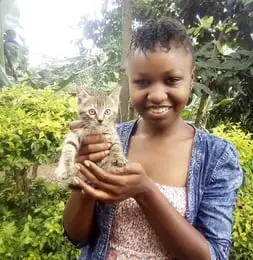
The answer to whether cat grass will spread:
Cat grass will not spread because it is mainly oat, wheat seeds, barley, or rye. combinations, that do not reproduce. It grows for between 2 to 3 months then dies.
A cat nibbles on it within a few inches, and the grass grows back but cannot spread.
It is not the same kind of grass used forlawns.
If you are blessed with a cat who loves their greens, you are probably thinking about providing them with cat grass on a small pot.
Most cat owners wonder if cat grass can spread the same way as other types of grass do. Read more, to know the answer.
Cat Grass Will Not Spread
If you put grass seed in a pot, it will not reproduce and spread that way because this type of grass does not reproduce.
Cat grass is not the same as the kind of grass one grows for the lawn.
As your cat keeps nibbling the grass to within a few inches of the soil, it dies and then grows back but will not spread within the container.
Cat grass is mainly grown from oat, wheat seeds, barley, or rye. Most of the time, cat grass is a blend of all these seeds. You can also choose to buy a single seed and grow it.
The seeds are large which makes it easy to see when planting.
You can find a variety of cat grass kits from your local pet store, including seeds, soil, and a potting container.
Here is what you need to know about each of these seeds used in cat grass:
- Wheatgrass: It is one of the most popular choices of cat grass. Yes, your furry friend also appreciates the nutritional benefits of wheatgrass. If you already growing this type of grass, it will be easier to plant an extra tray for your cat.
- Barley grass: This cereal grain provides nice grass for your cat to nibble. It is rich in minerals and easily blends into a cat grass mix.
- Oat grass: This kind of grass is sweet to taste and high in fiber. Your cat will love this choice.
- Flax: Most cat grass blends don’t have this one, but it can be a great addition. Its stalks resemble grass but it has shorter leaves than the other grass types.
How Grass Usually Spreads

To understand why cat grass does not spread, let’s learn how grass normally spreads.
The seeds are produced from a cluster of flowers which are known are inflorescence. The flowers develop once the plant has developed a number of leaf blades.
Grass flowers contain male and female reproductive organs in separate flowers. They are then fertilized with pollen from a genetically compatible grass flower.
Each shoot (tiller) that grows out of the plant produces seed from its own inflorescence.
Insects or the wind transfer pollen from the male flowers to the female flowers.
Rhizomes
Rhizomes are underground stems that grow outward from the plant’s base. As these rhizomes spread below the soil, grass spreads vegetatively through them.
Stolons
Stolons are lateral stems that grow from the crown at the plant’s base and above the soil. Some grass species spread from stolons while others spread from both stolons and rhizomes. The latter type can spread into a dense lawn if encouraged to grow.
Watering the grass encourages it to grow and spread rapidly.
How Cat Grass Combinations Grow
One wheatgrass seed germinates sprouts and grows. The sprout then starts changing composition to encourage the reproduction process.
Wheatgrass grows vertically and needs a hard structure to grow that way. Therefore, it makes a hard stalk to rise and stand.
Wheatgrass is harvested after thin blades of grass sprout.
Rye grass germinates faster than lawn grass. However, it spreads slowly and does not do so by stolons or rhizomes the way grass spreads.
Rye grass grows in vertical shoots.
So cat grass does not spread because the breedss used to make it germinate in a different way.
Choosing a Cat Container to Stop it Spreading
Its best to choose a container that will prevent the cat grass from going all over your home when your cat eats it.
When looking for a suitable container to grow cat grass, size matters. You want a wide enough container for your cat to access the grass, and one that is heavy so that it cannot easily tip over.
An-appropriately sized container provides the space for the grass to grow properly.
You also need drainage too if you are using soil or soil-free methods. Bonsai pots are a favorite among many cat owners because these containers are shallow so your cat can enjoy its greens at a suitable height, not standing on its hind legs.
The pots are made of ceramic and have a good weight that cats cannot topple over.
If you are growing seeds in water only, a container that can hold water will be fine. Just make sure it has weight.
The type of grass you are using also determines the type of container you need to use. Wheatgrass will thrive well in a pot that is 7 inches in diameter and 3 inches deep.
The type of soil should be lightweight potting mix. Don’t use garden soil as it is too much dense.
Oat seeds require a large container. Sometimes weeds make their way inside the planter and it will be easier to see them, and pull them out when the container is large.
It thrives in wet or dry soil and doesn’t need a lot of nutrients.
You also need to consider your cat’s preference. If your cat hates bright colors avoid getting a yellow planter.
Your feline friend should feel comfortable approaching the container, and eating from it.
Cat Grass in Soilless Media Is Less Messy
You can use soil-free media to start cat grass, such as coconut coir. Some cat owners say they prefer to mix their own; coconut coir, horticultural perlite, and vermicast.
Using a soil-free medium has an advantage in that it is less messy to clean up. As your cat chews on the grass blades, they are likely to pull out the blade by its roots, scattering the dirt all over the place.
Using a soilless medium prevents clumps of soil from sticking on your cat’s paws. The process of starting your soil in a soil-free medium is almost the same as starting them in soil.
- Fill your pot to about ¼ inch below where you want it to be.
- Add seeds that were previously soaked, and then fill the remaining ¼ of your medium.
- Water it well but don’t overdo it.
Cat Grass is Safe
As long as your cat eats it in moderation, cat grass is safe. It is much better than letting your cat nibble on the grass outside.
Most lawns are full of fertilizers, weed killers, and pesticides, and these may not be safe for your furry friend to ingest.
By growing your cat grass, you are in full control of how it’s cared for, right from growing to harvesting. You don’t have to worry about your cat eating harmful chemicals.
Even if your cat is sensitive to a particular type of grass, you can make a seed blend that is modified according to their needs.
How to Grow Cat Grass by Soil
Your cat grass kit comes with directions on how to grow, but you can follow these basic tips:
1. Sow your seeds
Sow seeds ¼ inch deep in the container where the grass will grow. Sometimes the kit comes in durable ceramic pots, but unfortunately, most pots are made of cheap plastic.
Ensure the seeds are damp but don’t soak them. You can partially cover the pot with plastic wrap, and place it in a warm place.
2. Provide direct sunlight
Cat grass needs a lot of sunlight to thrive. Place in direct sunlight or near the window. If there is no direct sunlight, grow the seedlings beneath a fluorescent plant light.
Move the lights a bit high as the grass grows taller. Incandescent bulbs cannot be used because they get too hot.
Allow up to 7 days for the seeds to sprout, but mostly they start growing at day 3.
3. Use less water
Once they sprout use less water but keep the soil moist and firm. When the soil is too wet, the seedlings may appear healthy, but then suddenly they wilt, die and wither.
This situation is called Damping-off. It is caused by a fungus that is active in an environment where there is too much moisture.
Your cat can eat the grass in 10 to 14 days after sprouting. Don’t remove the grass from the container, your cat can eat directly from the container.
4. Replant
When the grass changes color, plant a new one.
It’s best to find a medium-sized planter that has some weight so that your cat will not tip it over or move it around the floor. Keep the sides of the planter short to make it comfortable for your cat to eat from it.
If you have planting soil at home, try mixing it with the dirt that comes with the kit. This helps the seed have a good growing medium.
Don’t cover the seed too deep inside the soil.
How to Start Cat Grass in Water
If you can’t find soil or dirt, water alone can do the job.
- Find a container that does not have drainage holes.
- Fill the lower part of the container with clay pellets or grow stones.
- Some cat owners like a lightweight medium like perlite. This is fine, too but ensures you monitor closely.
- Fill with water which has to be the same levels as perlite. They are not supposed to float on top.
- Place a coffee filter or a paper towel on top of your media.
- Place your already soaked seeds on top of the filter.
- Once the seeds start to sprout, they will penetrate the filter and go right down to the media.
- Ensure the roots can find water.
Why Cats Eat Grass
According to an animal behaviorist, Carlo Siracusa cats eat grass because it is a behavioral instinct. Felines in the wild eat grass after they have eaten prey which often causes them to vomit.
It could be their natural way of expelling eaten prey that cannot be digested.
The grass is also a good source of fiber that helps your cat throw up ingested hairballs, or digest them by acting as a laxative.
Cat grass is a blend of cereal grasses safe for animals to consume. It offers a natural way to add more vitamins to your feline companion’s diet.
The benefit of growing cat grass is that it can act as a deterrent. If your cat likes to chew on houseplants, cat grass will lure it away from your delicate houseplants.
How to Know When it’s Too Much
Cats are carnivorous so obviously, grass should not be their only food source. Every cat responds differently to cat grass.
It would be best if you give yours a small amount and see if they like it or not. If your cat ignores the grass, perhaps it just does not want it at that particular time.
Some cats will start festering on it immediately and there is nothing wrong with that, either.
If your cat shows interest, limit its intake to a small amount first to see how they handle it. Some cat owners suggest 2 to 3 grass sessions a week.
If your cat wants to eat the grass constantly, it could be an indication of a bigger problem. You might want to go to a vet to check what’s wrong.
